I used a polyester capacitor (type used in fluorescent tubes or motor run applications) in my active speakers, can't remember exact value, think it was 33uf 450v, quite big physically, cheap(ish), but sounds awesome to me. Also have passive crossovers for the same speakers, using electrolytic caps for bass and "better quality" film caps for mid range and tweeter, I like the sound both ways.
My view: Just use something decent you can afford, and you are happy using.
The aluminium electrolytic + polyester/polypropylene in parallel is a good option. Good value and a good way to get going. Some back-to-back polarised electrolytic caps and a film cap in parallel is easy and cheap to do, you might have suitable parts lying around to try. If you can measure capacitance you can match them well for each channel. You can always use them for a comparison with something better.
Full polyester or polypropylene is better is you worry about having to replace the electrolytic in the future, but sound improvements would be down to your ears to judge.
The best option, just use something and enjoy them. Better to listen to music than spend too much time discussing what is better...
My view: Just use something decent you can afford, and you are happy using.
The aluminium electrolytic + polyester/polypropylene in parallel is a good option. Good value and a good way to get going. Some back-to-back polarised electrolytic caps and a film cap in parallel is easy and cheap to do, you might have suitable parts lying around to try. If you can measure capacitance you can match them well for each channel. You can always use them for a comparison with something better.
Full polyester or polypropylene is better is you worry about having to replace the electrolytic in the future, but sound improvements would be down to your ears to judge.
The best option, just use something and enjoy them. Better to listen to music than spend too much time discussing what is better...
I measured the SET. I connected the amp to a midrange driver so I didn't need to worry about protection, then inserted the meter in the circuit between amp and driver, and measured upon turn-on, idle (no sound played), and at turn off:Most volt/ohm meters can be used to measure DC current. Check how in the manual, should be something like this:
https://www.electricaltechnology.org/2021/06/measure-current-using-multimeter.html
- Turn-on: transient about 8mA (of course the actual might be higher but this is what the meter registered). No noise was heard. FWIW midrange driver is 100dB sensitive.
- Idle: 0.002 to 0mA, negligible, in line with your comment above that transformer-coupled SET shouldn't pass DC.
- Turn-off: 22mA peak on 1st measurement, 16mA peak on a 2nd measurement. A sound is heard...more like a click than a thump...I wonder about the lower frequency content this has.
The Beyma TPL150 tweeter is rated 80W and the 45-type SET is 2W, but of course little power would be required to fry the tweeter with low frequencies. Sounds like a case to keep the protection caps in the signal? I should I do more exploration?
I forgot to mention that when idle and very close to the driver I could hear some soft hum. Maybe this is a good reason to keep the caps in.I measured the SET. I connected the amp to a midrange driver so I didn't need to worry about protection, then inserted the meter in the circuit between amp and driver, and measured upon turn-on, idle (no sound played), and at turn off:
- Turn-on: transient about 8mA (of course the actual might be higher but this is what the meter registered). No noise was heard. FWIW midrange driver is 100dB sensitive.
- Idle: 0.002 to 0mA, negligible, in line with your comment above that transformer-coupled SET shouldn't pass DC.
- Turn-off: 22mA peak on 1st measurement, 16mA peak on a 2nd measurement. A sound is heard...more like a click than a thump...I wonder about the lower frequency content this has.
The Beyma TPL150 tweeter is rated 80W and the 45-type SET is 2W, but of course little power would be required to fry the tweeter with low frequencies. Sounds like a case to keep the protection caps in the signal? I should I do more exploration?
A 37uF cap probably won't do much to filter out the harmonics of the AC line hum you are hearing.I forgot to mention that when idle and very close to the driver I could hear some soft hum. Maybe this is a good reason to keep the caps in.
I wasn't hearing this with the SET connected to the tweeters. Not sure what to make of this, but it wasn't there. Maybe something other than the caps was filtering this.A 37uF cap probably won't do much to filter out the harmonics of the AC line hum you are hearing.
Would the DC current measured at turn-on/off be an issue for the tweeters without a cap?
Right. This discussion is weird for skirting the only issues that matter, weltersys's apt post excepted.A 37uF cap probably won't do much to filter out the harmonics of the AC line hum you are hearing.
You need to know the impedance (and the DC resistance) of the tweeter and the XO frequency. Duh. So long as the cap isn't interfering more than a dB or two in the passband, you're good to go (of course, I am a phase audibility denier).
Had the same issue myself not long ago. For sure you don't want to attach a tweeter to the amp terminals without a cap to protect it. You don't want an electrolytic cap because they charge (and maybe lacking audiophile cred too). Not too big (as weltersys points out) and not too small (just to save money).
Practical hint: always buy a handful of caps so you can choose a matched pair.
B.
The tweeter is Beyma TPL-150H which has a resistive impedance of 5 Ohm. The paralleled caps add to a protection cap equal to 37.6 uF, which implies a corner frequency about 700-800Hz if I recall correctly. The digital xo is set at 1300Hz so the cap doesn't have much impact when playing music. But I wonder if the cheap caps are detrimental to sound quality vs an "audiophile" cap. Neither I want to waste money if this isn't going to have an impact.Right. This discussion is weird for skirting the only issues that matter, weltersys's apt post excepted.
You need to know the impedance (and the DC resistance) of the tweeter and the XO frequency. Duh. So long as the cap isn't interfering more than a dB or two in the passband, you're good to go (of course, I am a phase audibility denier).
Had the same issue myself not long ago. For sure you don't want to attach a tweeter to the amp terminals without a cap to protect it. You don't want an electrolytic cap because they charge (and maybe lacking audiophile cred too). Not too big (as weltersys points out) and not too small (just to save money).
Practical hint: always buy a handful of caps so you can choose a matched pair.
B.
From the measurements mentioned above it seems keeping the protection cap is probably best way forward with my SET amp.
By my amateur arithmetic, I hate to confirm it, but 37.6 uF is not too big. Comes in around 3 Ohms or so at 1300 Hz.
Even so, no need to go to a non-polarized electrolytic cap. Should be some bargains out there. My usually pragmatic (that is, cheap) POV is that there are no audible differences among the caps other than electrolytic or tantalum types. And many would say our music is already passing through dozens of electrolytic caps.
B.
Even so, no need to go to a non-polarized electrolytic cap. Should be some bargains out there. My usually pragmatic (that is, cheap) POV is that there are no audible differences among the caps other than electrolytic or tantalum types. And many would say our music is already passing through dozens of electrolytic caps.
B.
From the measurements in post #43, the Beyma TPL-150H should have no problems with the the transformer coupled SET's output.The digital xo is set at 1300Hz so the cap doesn't have much impact when playing music. But I wonder if the cheap caps are detrimental to sound quality vs an "audiophile" cap. Neither I want to waste money if this isn't going to have an impact.
From the measurements mentioned above it seems keeping the protection cap is probably best way forward with my SET amp.
Setting aside any sound quality difference between caps, the 37.6uF cap will definitely impart a measurable phase shift which affects frequency response and directivity through the acoustic crossover region, requiring a different filter or delay (or both) to compensate for the difference compared to without.
I connected the SET to the midrange driver, no protection cap, and measured the spectrum of ambient noise (black; quiet house) and the trace upon turn-off (red). The noise does have lower frequencies down to about 300Hz, but their magnitude might be low enough to be safe to use this amp on the tweeter without protection cap? About 15-20dB at 600Hz. It's a pro AMT, 102dB/W, rated 80W played above 1100Hz.

I've asked something similar in this regards some time ago, also an old JBL whitepaper recommended this resistor as well across the compression driver.That's not just a lack of damping factor, that's surely a resonance between the tweeter's inductance or mechanical impedance and the capacitor. A resistor across the tweeter (and/or in series with the cap) would surely help a lot, and a (low power) frequency sweep with and without a resistor would show the problem. Now that I read about this, I wouldn't want to use a capacitor by itself without something to damp such a resonance.
CD's + DC blocking cap + damping factor
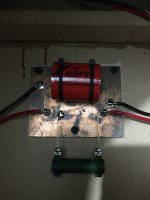
Since I use DSP I've ended up removing the Cap/Resistor, since after playing with XSim and REW noticed some phase changes near the crossover point, minimal but they where there despite using the recommended cap value.
Now I just use the old-school way of using a very small fast-blown quality BUSS fusible and holders for protecting the tweeters in case the amplifier gone wild regardless having DC protection, but beware this does not protect against end-user error playing with the DSP but just overload and/or DC surges.
Here is the DIY fuse box made with an 4x4 junction-box and speakon connectors for reference:
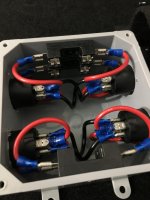
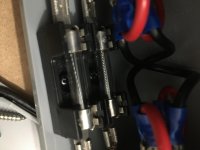
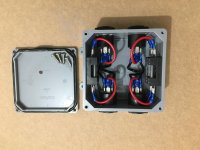
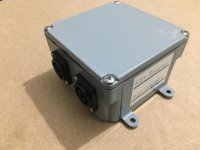
The F1 is 1A for protecting the compression drivers, however the F2 is 9A(a bit oversized) as I don't care much for the midbasses as those can handle more abuse.
Regards
Can't say much about the mystery resonance and resistor damping, but basic electricity suggests a resistor is needed around driver.That's not just a lack of damping factor, that's surely a resonance between the tweeter's inductance or mechanical impedance and the capacitor. A resistor across the tweeter (and/or in series with the cap) would surely help a lot, and a (low power) frequency sweep with and without a resistor would show the problem. Now that I read about this, I wouldn't want to use a capacitor by itself without something to damp such a resonance.
That's because at resonance, the driver impedance goes way high (at least for voice coil drivers). So a capacitor which protects the driver at ordinary driver impedances, would be much less effective at resonance... just where you need it the most (even though that's lower in freq than the rest of the tweeter passband).
B.
That's what I was trying to say in my earlier post. The "damping factor" as seen by the driver at (electrical) resonance is NOT simply (as someone else was saying) the reactance of the capacitor at that frequency, it is much higher due to the inductance of the driver. Due to it being a tuned electrical circuit, the voltage across the driver can be MUCH HIGHER than the voltage from the amplifier at the circuit's resonant frequency. The only damping is the voice coil resistance (and also the speaker cable resistance and amp output impedance in series, but they're surely less than voice coil resistance).Can't say much about the mystery resonance and resistor damping, but basic electricity suggests a resistor is needed around driver.
That's because at resonance, the driver impedance goes way high (at least for voice coil drivers). So a capacitor which protects the driver at ordinary driver impedances, would be much less effective at resonance... just where you need it the most (even though that's lower in freq than the rest of the tweeter passband).
B.
If there are some values for driver inductance at various frequencies, this extra-high output at resonance with a series capacitor can easily be shown in a circuit simulation.
It doesn't. Please see the text in that post.Does that plot show the level of power going into the tweeter at maybe 90 dBC? That's the comparison to the signal at turn-on and turn-off transients.
B.
I'm measuring the noise the amp makes at turn-off, so I connect ithe amp directly to a midrange driver to be safe any lower frequencies won't damage the driver, and measure the spectrum of the noise.
Black line is without any sound being produced - ambient noise. About 55dB.
Red line is the noise measured at turn off, which indeed has lower frequencies down to 250/300Hz. If loud enough these frequencies would destroy the tweeter, specified for above 1100Hz 2nd order xo, but at 80W.
I guess the question boils down to whether the frequencies down in the 300-600Hz region are loud enough to damage the driver?
The question is: how big do the peaks ever get when you playing music loud?
If you tweeter can graciously handle those peaks, then you can have more perspective on how it can handle the "undocumented" voltages from the amp. Not a perfect picture (freq and duration and type of tweeter also matter) but a good benchmark.
I'd plot the amp thumps going into a resistor.
B.
If you tweeter can graciously handle those peaks, then you can have more perspective on how it can handle the "undocumented" voltages from the amp. Not a perfect picture (freq and duration and type of tweeter also matter) but a good benchmark.
I'd plot the amp thumps going into a resistor.
B.
Can you elaborate why this would be "the" question?The question is: how big do the peaks ever get when you playing music loud?
While playing music the active xo filters frequencies below 1300Hz so it's not an issue. Plus the 45-type SET is rated 2W while the tweeter is rated 80W...so while playing music it looks like a non-issue to me.
The problem might arise when I turn off the amp and low frequency noise is generated after the active xo. Hence my question.
Also don't see how measuring voltage over a resistor would offer much different insight than measuring sound spectrum from the midrange woofer. Can you help me understand?
- Home
- Loudspeakers
- Multi-Way
- Capacitor to protect Tweeter in active speaker, cheap or quality?